Turbulence of Landward and Seaward Wind during Sea-Breeze Days within the Lower Atmospheric Boundary Layer
Abstract
:1. Introduction
2. Data and Methods
2.1. Study Area, Data Collection and Sea-Breeze Detection
2.2. Methodology
3. Characteristics of Seaward and Landward Wind Turbulence
3.1. Assessment of TKE and Rms Velocity
3.2. Probability Density of Energy Dissipation Rate and Length-Scale of Turbulent Eddies
3.3. Quadrant Analysis of TKE Fluxes
3.4. Reynolds Stress Anisotropy
4. Conclusions
- During the SB days the TKE is relatively larger for LWD compared to SWD winds.
- The TKE dissipation rate is smaller for SWD wind than for LWD wind, resulting in larger sized (maximum probability of occurrence of L = 25 m) turbulence eddies developing for LWD wind conditions and smaller sizes (maximum probability of occurrence of L = 20 m) for SWD wind conditions.
- During SB days, the LWD wind blows along the streamwise direction, but the TKE flux is opposite to the mean flow. We found that this flux causes an increase in TKE dissipation rate. On the contrary, during the SWD wind, equal distribution of TKE flux along and opposite the mean flow direction provides a decrease in TKE dissipation rate.
- The proposed modified AIM performed better to capture the exact size of stress spheroids after axisymmetric expansion and contraction than previous two-dimensional AIM. It is found that LWD wind turbulence is more anisotropic than that of SWD wind. Prolate and oblate stress spheroids are formed due to this anisotropy.
- Large fluctuations of TKE in the flow field create large stress spheroids where the energy distribution is confined within a large area of prolate spheroids during LWD winds. On the contrary, during SWD winds, small fluctuations of TKE in the flow field give rise to a small oblate stress spheroids with the energy distribution limited to a smaller area of spheroid.
Author Contributions
Funding
Institutional Review Board Statement
Informed Consent Statement
Data Availability Statement
Conflicts of Interest
Appendix A
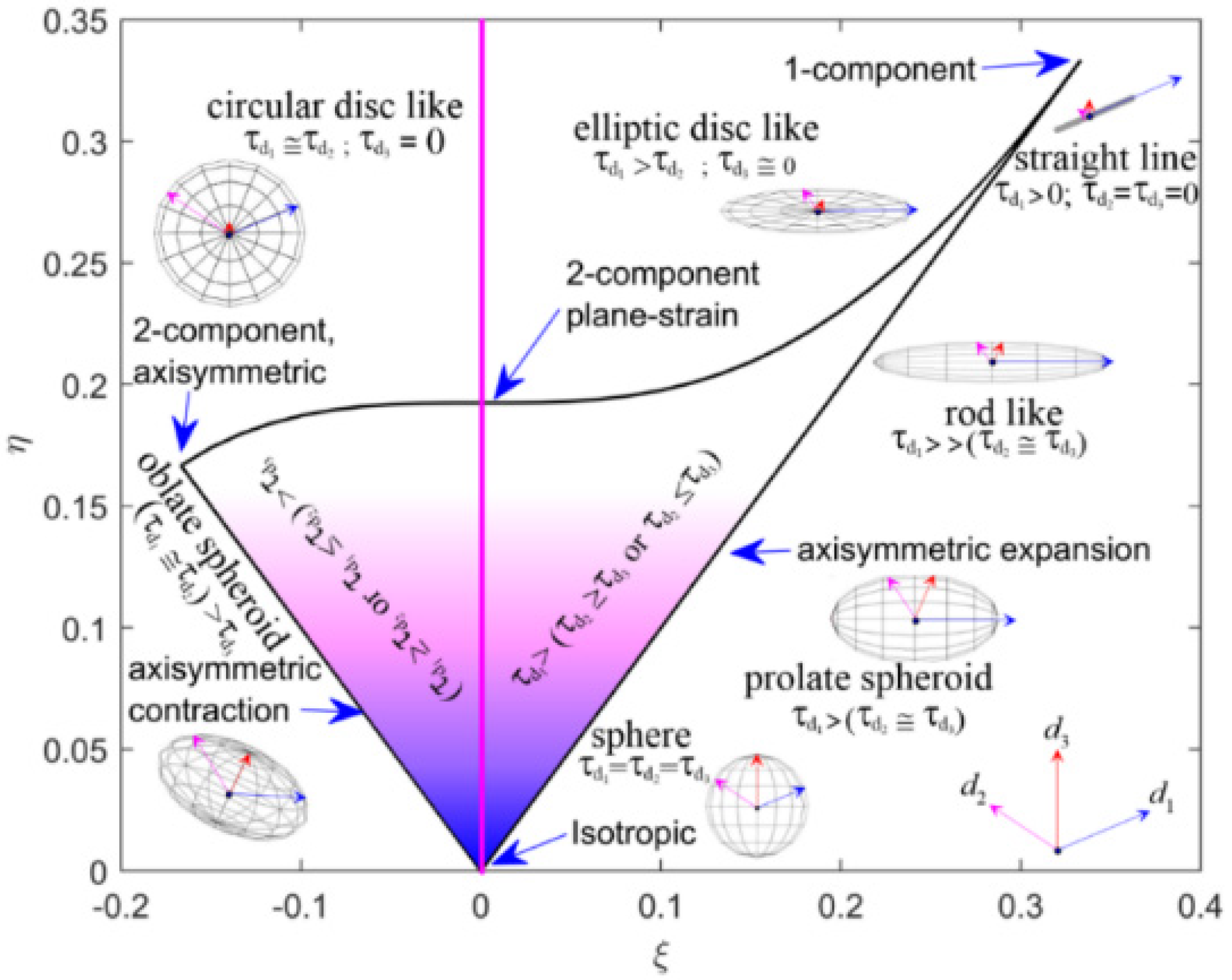
References
- Augustin, P.; Billet, S.; Crumeyrolle, S.; Deboudt, K.; Dieudonné, E.; Flament, P.; Fourmentin, M.; Guilbaud, S.; Hanoune, B.; Landkocz, Y.; et al. Impact of sea breeze dynamics on atmospheric pollutants and their toxicity in industrial and urban coastal environments. Remote Sens. 2020, 12, 648. [Google Scholar] [CrossRef] [Green Version]
- Setyan, A.; Flament, P.; Locoge, N.; Deboudt, K.; Riffault, V.; Alleman, L.Y.; Schoemaecker, C.; Arndt, J.; Augustin, P.; Healy, R.M.; et al. Investigation on the near-field evolution of industrial plumes from metalworking activities. Sci. Total Environ. 2019, 668, 443–456. [Google Scholar] [CrossRef]
- Talbot, C.; Augustin, P.; Leroy, C.; Willart, V.; Delbarre, H.; Khomenko, G. Impact of a sea breeze on the boundary-layer dynamics and the atmospheric stratification in a coastal area of the North Sea. Bound. Layer Meteorol. 2007, 125, 133–154. [Google Scholar] [CrossRef]
- Crumeyrolle, S.; Augustin, P.; Rivellini, L.H.; Choël, M.; Riffault, V.; Deboudt, K.; Fourmentin, M.; Dieudonné, E.; Delbarre, H.; Derimian, Y.; et al. Aerosol variability induced by atmospheric dynamics in a coastal area of Senegal, North-Western Africa. Atmos. Environ. 2019, 203, 228–241. [Google Scholar] [CrossRef]
- Augustin, P.; Delbarre, H.; Lohou, F.; Campistron, B.; Puygrenier, V.; Cachier, H.; Lombardo, T. Investigation of local meteorological events and their relationship with ozone and aerosols during an ESCOMPTE photochemical episode. Ann. Geophys. 2006, 24, 2809–2822. [Google Scholar] [CrossRef] [Green Version]
- Rizza, U.; Miglietta, M.M.; Anabor, V.; Degrazia, G.A.; Maldaner, S. Large-eddy simulation of sea breeze at an idealized peninsular site. J. Mar. Syst. 2015, 148, 167–182. [Google Scholar] [CrossRef]
- Baker, R.D.; Lynn, B.H.; Boone, A.; Tao, W.K.; Simpson, J. The influence of soil moisture, coastline curvature, and land-breeze circulations on sea-breeze-initiated precipitation. J. Hydrometeorol. 2001, 2, 193–211. [Google Scholar] [CrossRef] [Green Version]
- Miao, J.F.; Wyser, K.; Chen, D.; Ritchie, H. Impacts of boundary layer turbulence and land surface process parameterizations on simulated sea breeze characteristics. Ann. Geophys. 2009, 27, 2303–2320. [Google Scholar] [CrossRef]
- Haeffelin, M.; Angelini, F.; Morille, Y.; Martucci, G.; Frey, S.; Gobbi, G.P.; Lolli, S.; O’dowd, C.D.; Sauvage, L.; Xueref-Rémy, I.; et al. Evaluation of mixing-height retrievals from automatic profiling lidars and ceilometers in view of future integrated networks in Europe. Bound. Layer Meteorol. 2012, 143, 49–75. [Google Scholar] [CrossRef]
- Briere, S. Energetics of daytime sea breeze circulation as determined from a two-dimensional, third-order turbulence closure model. J. Atmos. Sci. 1987, 44, 1455–1474. [Google Scholar] [CrossRef]
- Chiba, O. The turbulent characteristics in the lowest part of the sea breeze front in the atmospheric surface layer. Bound. Layer Meteorol. 1993, 65, 181–195. [Google Scholar] [CrossRef]
- Cenedese, A.; Miozzi, M.; Monti, P. A laboratory investigation of land and sea breeze regimes. Exp. Fluids 2000, 29, S291–S299. [Google Scholar] [CrossRef]
- Cuxart, J.; Jiménez, M.A.; Telišman Prtenjak, M.; Grisogono, B. Study of a sea-breeze case through momentum, temperature, and turbulence budgets. J. Appl. Meteorol. Clim. 2014, 53, 2589–2609. [Google Scholar] [CrossRef] [Green Version]
- Steele, C.J.; Dorling, S.R.; Glasow, R.V.; Bacon, J. Idealized WRF model sensitivity simulations of sea breeze types and their effects on offshore windfields. Atmos. Chem. Phys. 2013, 13, 443–461. [Google Scholar] [CrossRef] [Green Version]
- Steele, C.J.; Dorling, S.R.; von Glasow, R.; Bacon, J. Modelling sea-breeze climatologies and interactions on coasts in the southern North Sea: Implications for offshore wind energy. Q. J. R. Meteorol. Soc. 2015, 141, 1821–1835. [Google Scholar] [CrossRef] [Green Version]
- Kumar, R.; Stallard, T.; Stansby, P.K. Large-scale offshore wind energy installation in northwest India: Assessment of wind resource using Weather Research and Forecasting and levelized cost of energy. Wind. Energy 2021, 24, 174–192. [Google Scholar] [CrossRef]
- Mazon, J.; Rojas, J.I.; Jou, J.; Valle, A.; Olmeda, D.; Sanchez, C. An assessment of the sea breeze energy potential using small wind turbines in peri-urban coastal areas. J. Wind Eng. Ind. Aerodyn. 2015, 139, 1–7. [Google Scholar] [CrossRef] [Green Version]
- Lumley, J.L. Computational modeling of turbulent flows. Adv. Appl. Mech. 1979, 18, 123–176. [Google Scholar]
- Pope, S.B. Turbulent Flows; Cambridge University Press: Cambridge, UK, 2000. [Google Scholar]
- Lumley, J.L.; Newman, G.R. The return to isotropy of homogeneous turbulence. J. Fluid Mech. 1977, 82, 161–178. [Google Scholar] [CrossRef] [Green Version]
- Banerjee, S.; Ertunç, Ö.; Köksoy, Ç.; Durst, F. Pressure strain rate modeling of homogeneous axisymmetric turbulence. J. Turbul. 2009, 10, 29. [Google Scholar] [CrossRef]
- KiranKumar, N.V.P.; Jagadeesh, K.; Niranjan, K.; Rajeev, K. Seasonal variations of sea breeze and its effect on the spectral behaviour of surface layer winds in the coastal zone near Visakhapatnam, India. J. Atmos. Sol.-Terr. Phys. 2019, 186, 1–7. [Google Scholar] [CrossRef]
- Golzio, A.; Bollati, I.M.; Ferrarese, S. An assessment of coordinate rotation methods in sonic anemometer measurements of turbulent fluxes over complex mountainous terrain. Atmosphere 2019, 10, 324. [Google Scholar] [CrossRef] [Green Version]
- Dupuis, H.; Taylor, P.K.; Weill, A.; Katsaros, K. Inertial dissipation method applied to derive turbulent fluxes over the ocean during the Surface of the Ocean, Fluxes and Interactions with the Atmosphere/Atlantic Stratocumulus Transition Experiment (SOFIA/ASTEX) and Structure des Echanges Mer-Atmosphere, Proprietes des Heterogeneites Oceaniques: Recherche Experimentale (SEMAPHORE) experiments with low to moderate wind speeds. J. Geophys. Res. Ocean. 1997, 102, 21115–21129. [Google Scholar]
- Katul, G.G.; Parlange, M.B.; Albertson, J.D.; Chu, C.R. Local isotropy and anisotropy in the sheared and heated atmospheric surface layer. Bound. Layer Meteorol. 1995, 72, 123–148. [Google Scholar] [CrossRef] [Green Version]
- Katul, G.; Chu, C.R. A theoretical and experimental investigation of energy-containing scales in the dynamic sublayer of boundary-layer flows. Bound. Layer Meteorol. 1998, 86, 279–312. [Google Scholar] [CrossRef]
- Darbieu, C.; Lohou, F.; Lothon, M.; Vilà-Guerau de Arellano, J.; Couvreux, F.; Durand, P.; Pino, D.; Patton, E.G.; Nilsson, E.; Blay-Carreras, E.; et al. Turbulence vertical structure of the boundary layer during the afternoon transition. Atmos. Chem. Phys. 2015, 15, 10071–10086. [Google Scholar] [CrossRef] [Green Version]
- Hackerott, J.A.; Pezzi, L.P.; Bakhoday Paskyabi, M.; Oliveira, A.P.; Reuder, J.; de Souza, R.B.; de Camargo, R. The role of roughness and stability on the momentum flux in the marine atmospheric surface layer: A study on the southwestern atlantic ocean. J. Geophys. Res. Atmos. 2018, 123, 3914–3932. [Google Scholar] [CrossRef]
- Roy, S.; Sentchev, A.; Schmitt, F.G.; Augustin, P.; Fourmentin, M. Impact of the Nocturnal Low-Level Jet and Orographic Waves on Turbulent Motions and Energy Fluxes in the Lower Atmospheric Boundary Layer. Bound. Layer Meteorol. 2021, 180, 527–542. [Google Scholar] [CrossRef]
- Kumer, V.M.; Reuder, J.; Dorninger, M.; Zauner, R.; Grubišić, V. Turbulent kinetic energy estimates from profiling wind LiDAR measurements and their potential for wind energy applications. Renew. Energy 2016, 99, 898–910. [Google Scholar] [CrossRef] [Green Version]
- Puhales, F.S.; Demarco, G.; Martins, L.G.N.; Acevedo, O.C.; Degrazia, G.A.; Welter, G.S.; Costa, F.D.; Fisch, G.F.; Avelar, A.C. Estimates of turbulent kinetic energy dissipation rate for a stratified flow in a wind tunnel. Phys. A: Stat. Mech. Appl. 2015, 431, 175–187. [Google Scholar] [CrossRef]
- Choi, K.S.; Lumley, J.L. The return to isotropy of homogeneous turbulence. J. Fluid Mech. 2001, 436, 59–84. [Google Scholar] [CrossRef]
- Tijm, A.B.C.; Holtslag, A.A.M.; Van Delden, A.J. Observations and modeling of the sea breeze with the return current. Mon. Weather. Rev. 1999, 127, 625–640. [Google Scholar] [CrossRef]
- Liberzon, A.; Lüthi, B.; Guala, M.; Kinzelbach, W.; Tsinober, A. Experimental study of the structure of flow regions with negative turbulent kinetic energy production in confined three-dimensional shear flows with and without buoyancy. Phys. Fluids 2005, 17, 095110. [Google Scholar] [CrossRef]

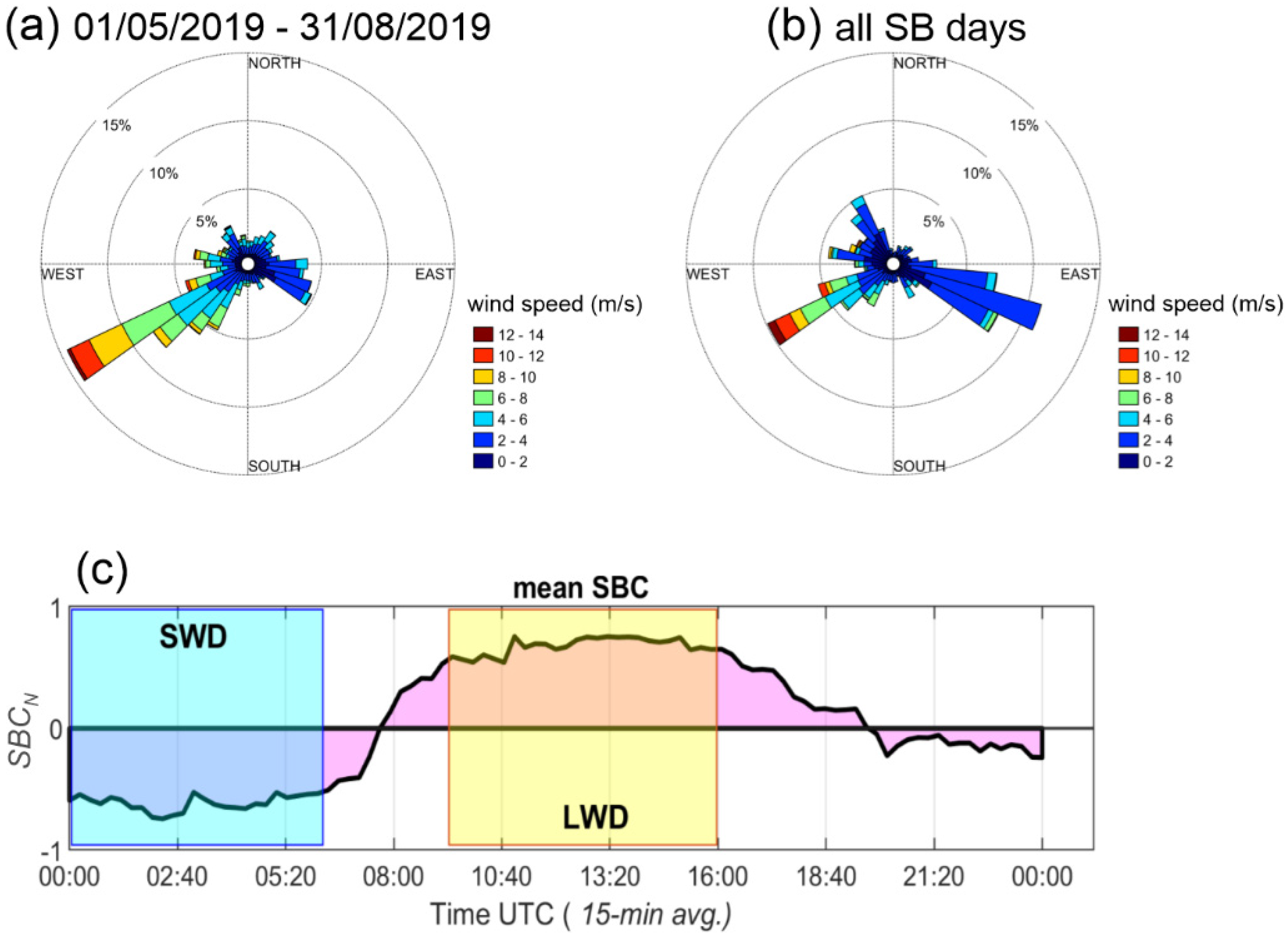
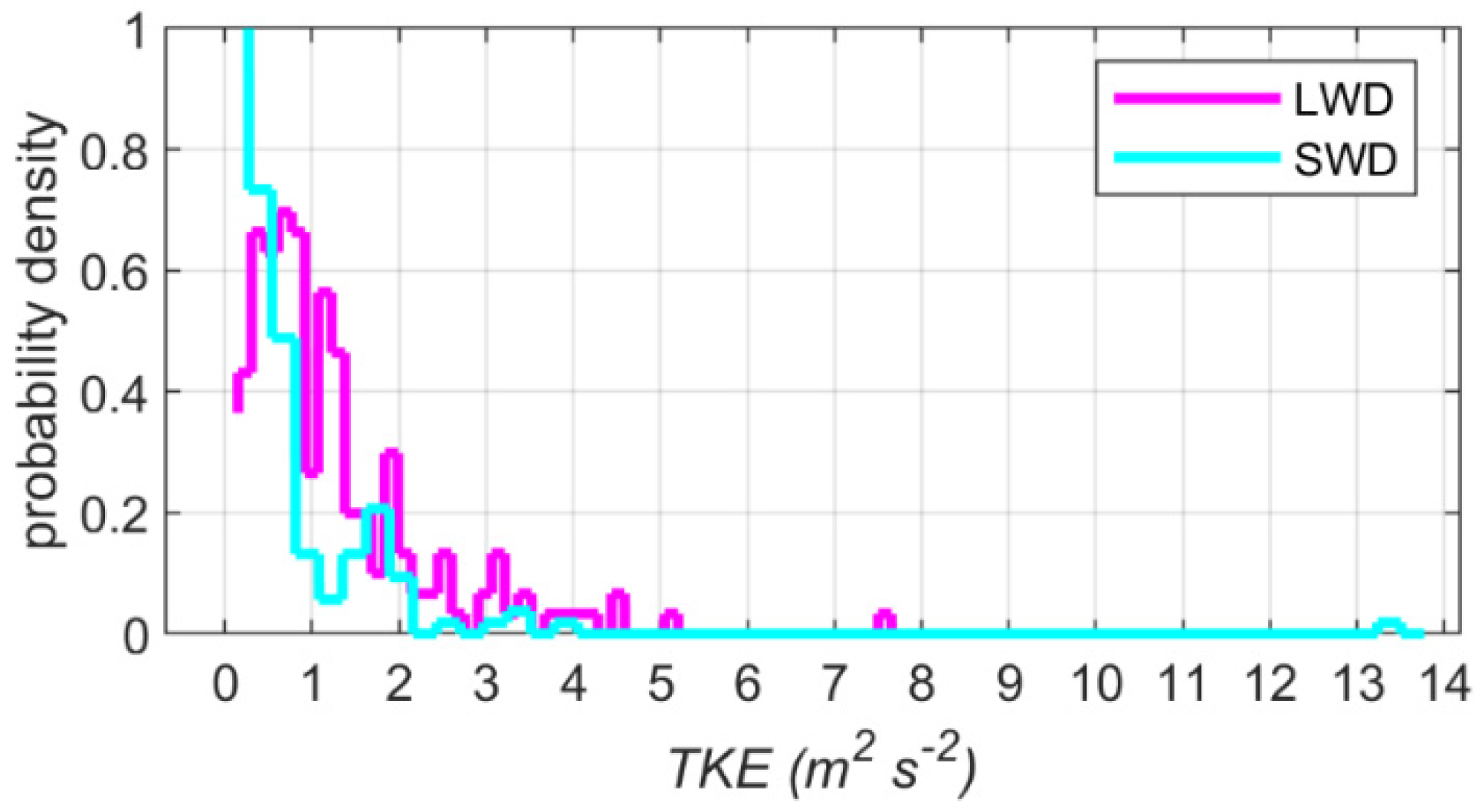


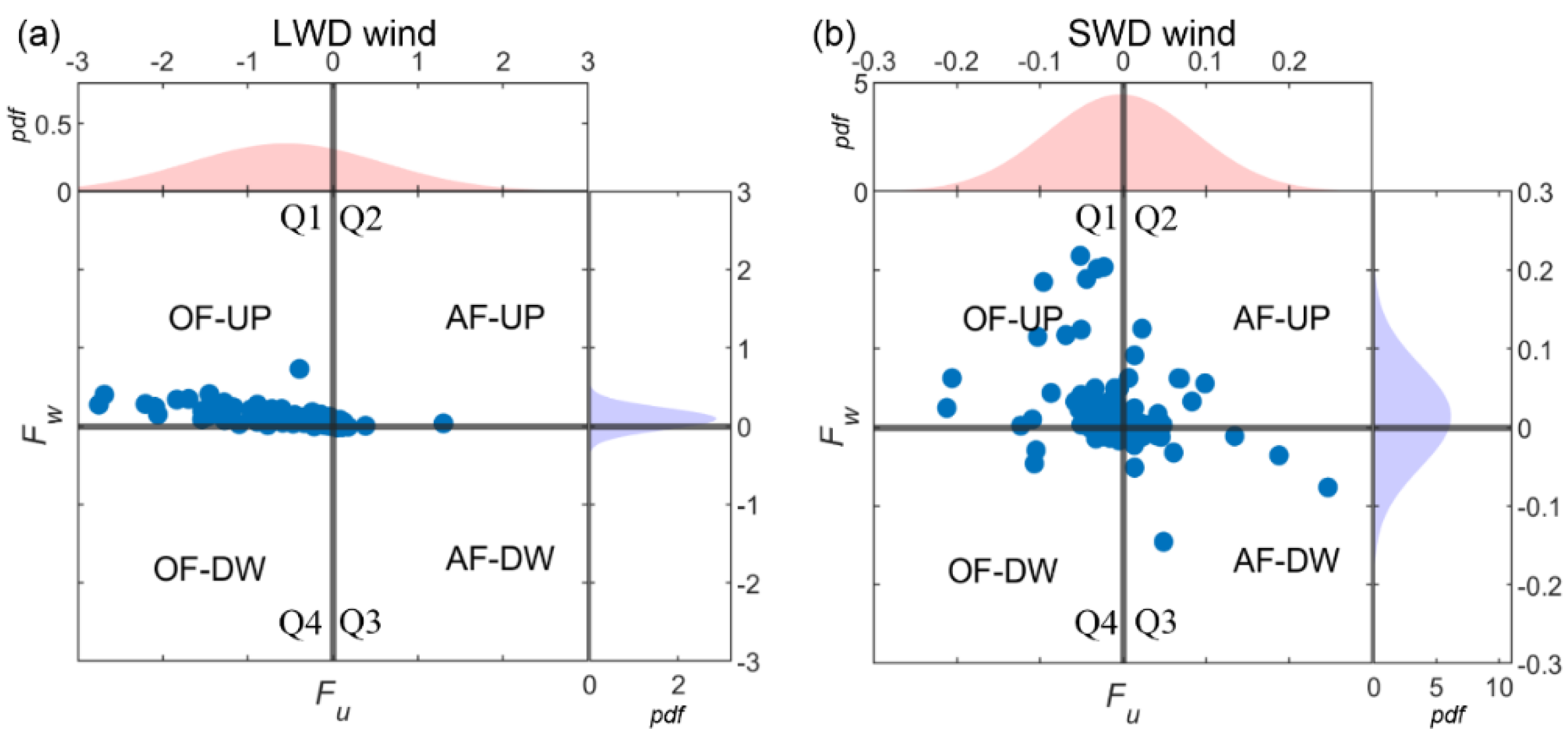
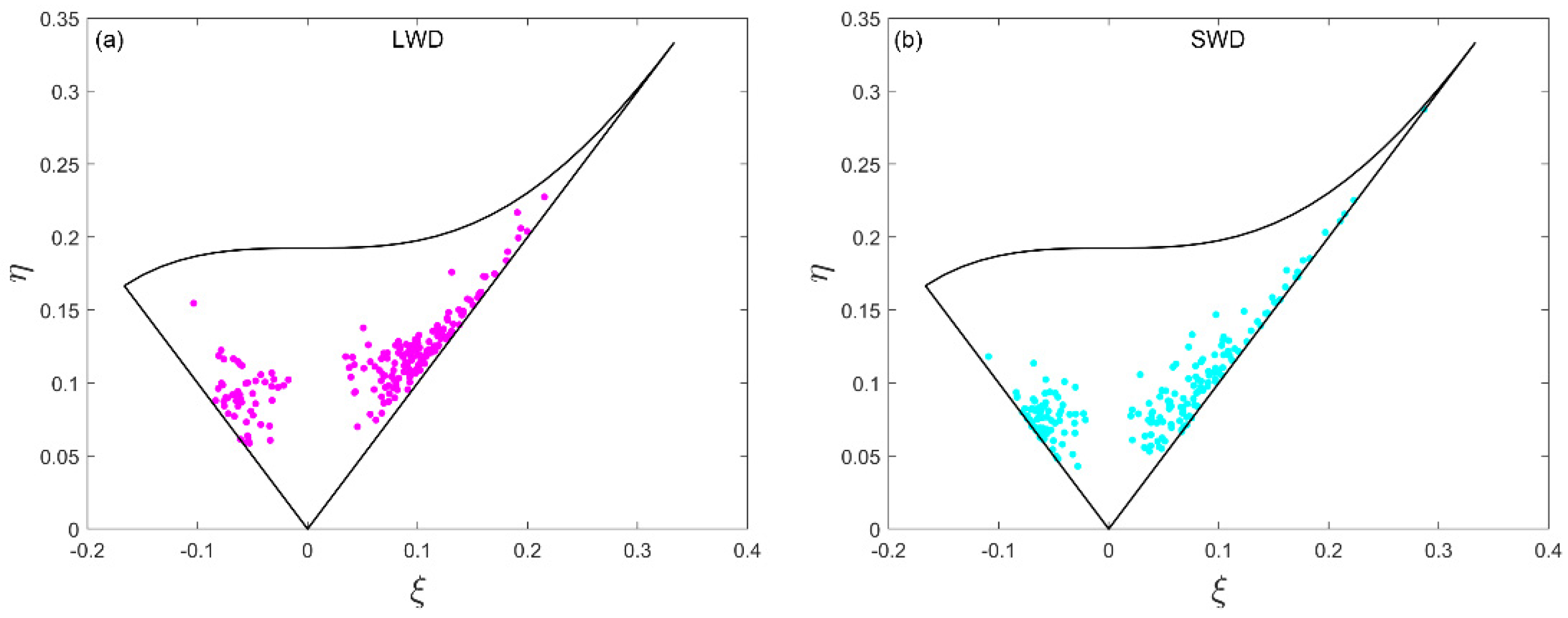
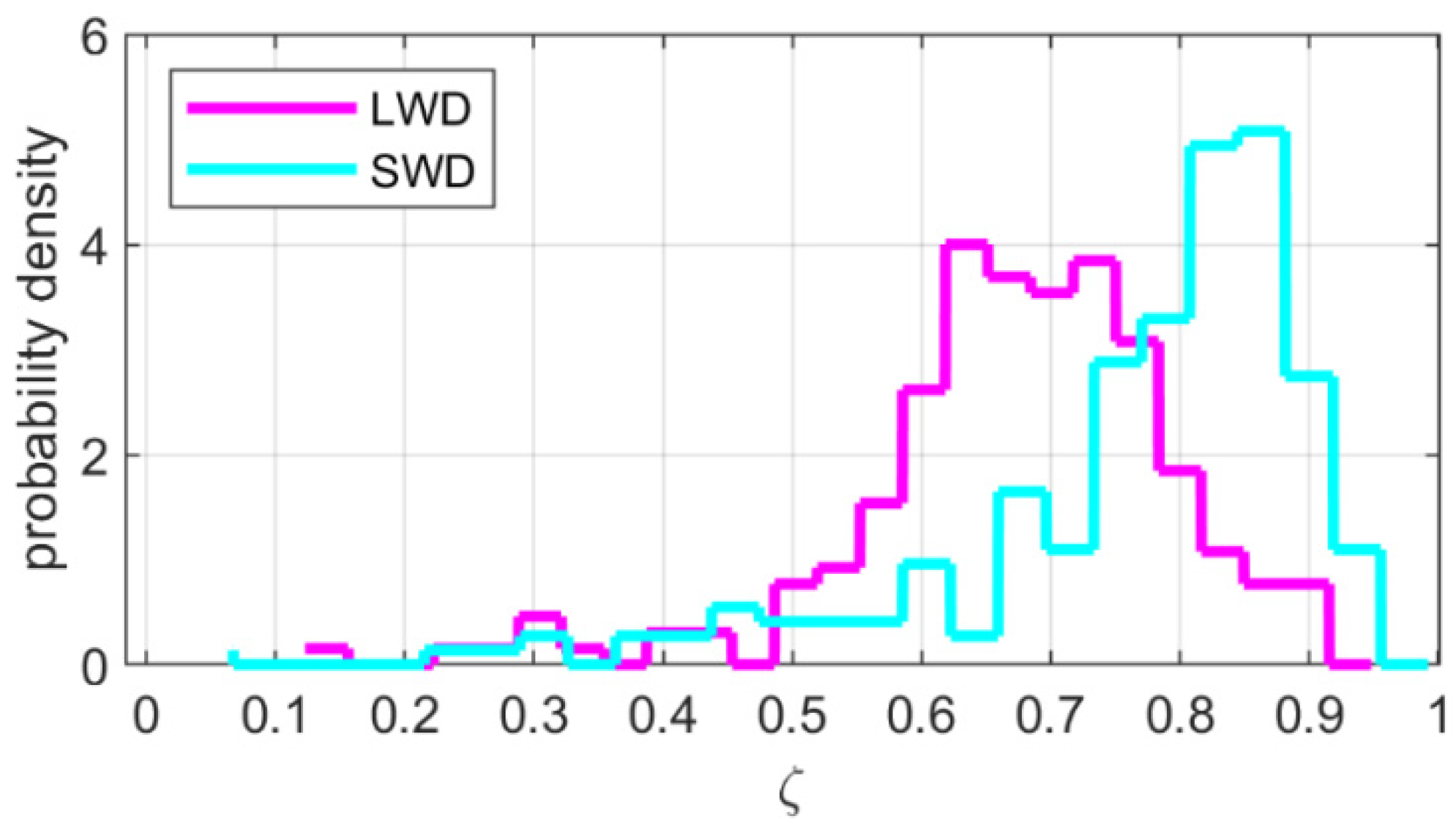
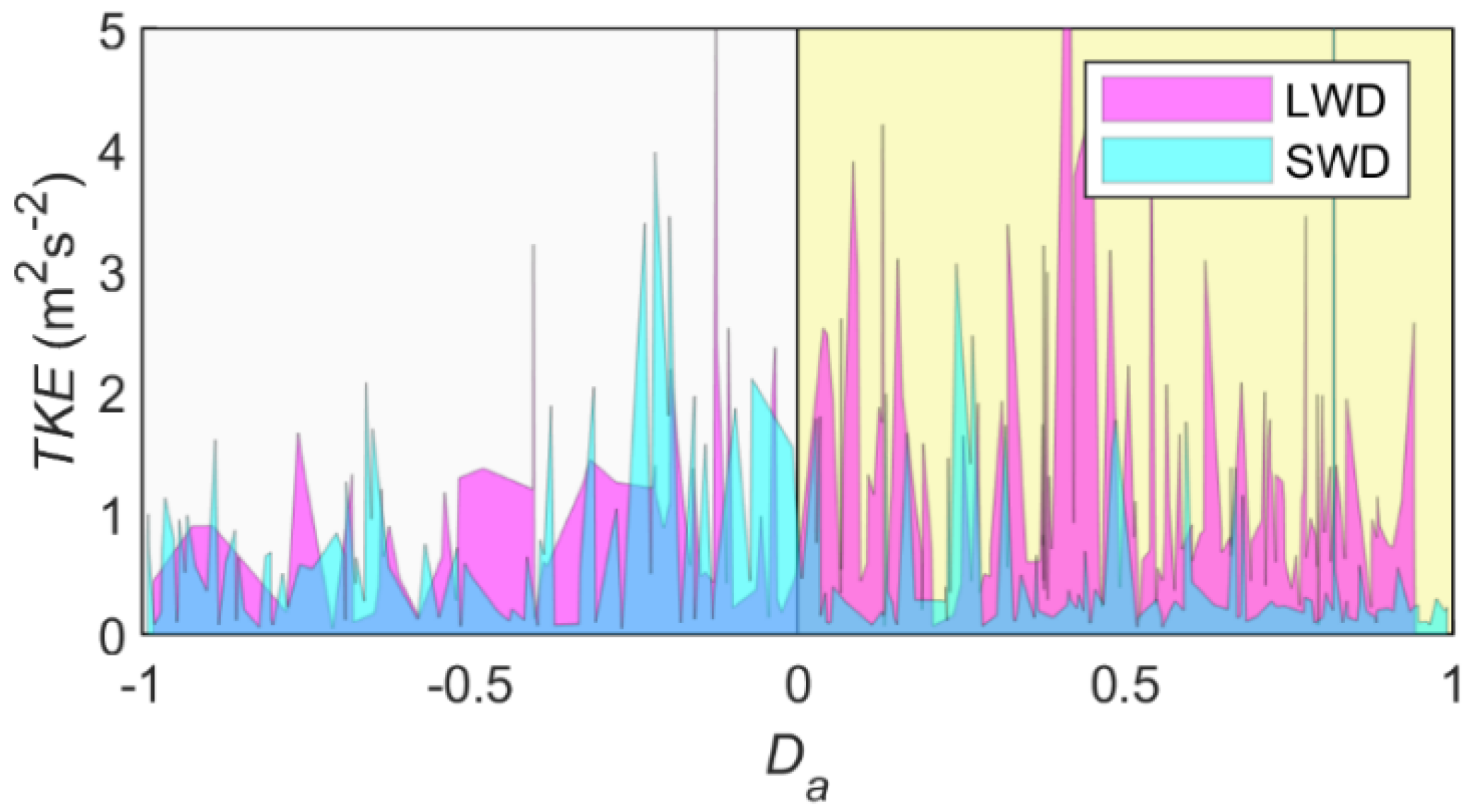
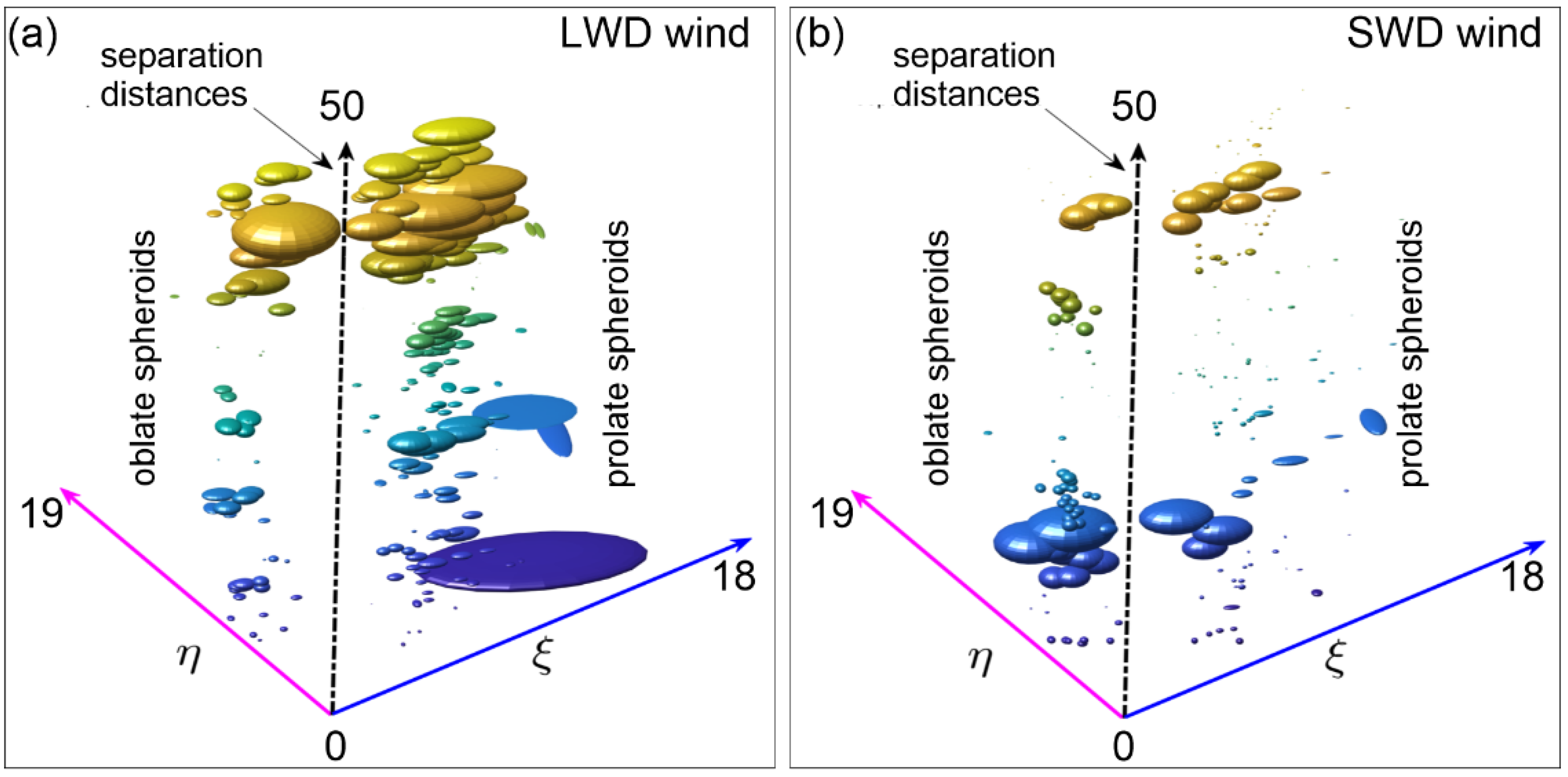
Publisher’s Note: MDPI stays neutral with regard to jurisdictional claims in published maps and institutional affiliations. |
© 2021 by the authors. Licensee MDPI, Basel, Switzerland. This article is an open access article distributed under the terms and conditions of the Creative Commons Attribution (CC BY) license (https://creativecommons.org/licenses/by/4.0/).
Share and Cite
Roy, S.; Sentchev, A.; Fourmentin, M.; Augustin, P. Turbulence of Landward and Seaward Wind during Sea-Breeze Days within the Lower Atmospheric Boundary Layer. Atmosphere 2021, 12, 1563. https://doi.org/10.3390/atmos12121563
Roy S, Sentchev A, Fourmentin M, Augustin P. Turbulence of Landward and Seaward Wind during Sea-Breeze Days within the Lower Atmospheric Boundary Layer. Atmosphere. 2021; 12(12):1563. https://doi.org/10.3390/atmos12121563
Chicago/Turabian StyleRoy, Sayahnya, Alexei Sentchev, Marc Fourmentin, and Patrick Augustin. 2021. "Turbulence of Landward and Seaward Wind during Sea-Breeze Days within the Lower Atmospheric Boundary Layer" Atmosphere 12, no. 12: 1563. https://doi.org/10.3390/atmos12121563





